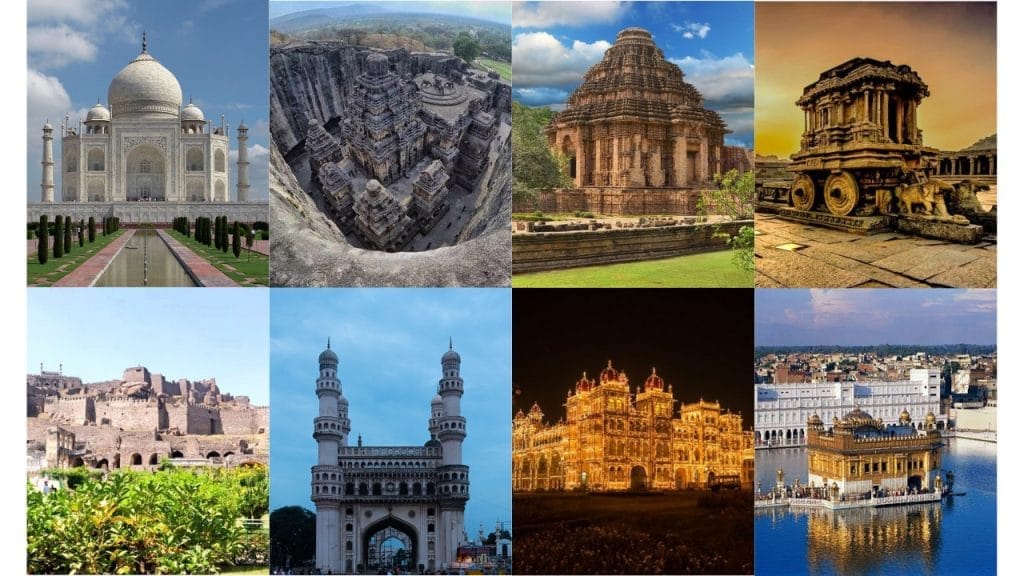India, a land saturated with history, culture, and normal magnificence, remains as a demonstration of the wealth of human civilization and the variety of our reality. From antiquated sanctuaries that reverberation with the murmurs of time to current wonders that grandstand mechanical ability, India’s embroidered artwork is woven with unprecedented miracles that keep on charming hearts and psyches the same. As a support of old civilizations and a guide of otherworldliness, it offers an entrancing mix of engineering brightness, regular scenes, and a kaleidoscope of customs. In this excursion through the “7 Wonders of India,” we leave on an investigation of a portion of the country’s most notorious and esteemed treasures that have made a permanent imprint on history and humankind.
7 Wonders of India
India is a place where there is rich social legacy and various normal excellence, flaunting various notorious tourist spots that grandstand its verifiable, building, and regular marvels. The following are seven of the most popular miracles of India, each with its own extraordinary importance:
Taj Mahal
Situated in Agra, Uttar Pradesh, the Taj Mahal is quite possibly of the most conspicuous landmark on the planet. Worked by Mughal Ruler Shah Jahan in memory of his significant other Mumtaz Mahal, it is an image of everlasting adoration and wonderful engineering. The white marble catacomb is decorated with mind boggling trim work, calligraphy, and lovely nurseries, making it an UNESCO World Legacy Site and one of the New Seven Miracles of the World.

Jaipur’s Amer Fort
Arranged in Jaipur, Rajasthan, the Amer Stronghold is a noteworthy illustration of Rajput engineering. Its greatness and multifaceted plan make it a well known traveler objective. The post is known for its creative components like the Sheesh Mahal (Mirror Royal residence) and the Diwan-e-Khas (Corridor of Private Crowd). Roosted on a slope, it offers staggering perspectives on the encompassing scene.
Hampi
An UNESCO World Legacy Site situated in Karnataka, Hampi was once the capital of the Vijayanagara Realm. The vestiges of this old city are spread across an immense region and incorporate sanctuaries, castles, commercial centers, and different designs, all exhibiting the fantastic design and designing ability of the domain. The Virupaksha Sanctuary, Vittala Sanctuary complex, and the Stone Chariot are a portion of its conspicuous attractions.
Khajuraho Group of Monuments
Situated in Madhya Pradesh, the Khajuraho Gathering of Landmarks is eminent for its unpredictable and extravagantly cut sanctuaries. These sanctuaries, worked somewhere in the range of 950 and 1050 Promotion by the Chandela tradition, highlight staggering figures that portray different parts of life, including legendary topics, erotic scenes, and regular exercises. The sanctuaries are perceived as an UNESCO World Legacy Site.

Qutub Minar
Arranged in Delhi, the Qutub Minar is a momentous illustration of Indo-Islamic design. It is the tallest block minaret on the planet and stands as a demonstration of the triumph of Muslim rulers in India. The complex carvings and engravings on its surface feature a mix of Islamic and neighborhood engineering styles. The Qutub Minar complex additionally incorporates other authentic designs like the Quwwat-ul-Islam Mosque and the Iron Point of support.
Ajanta and Ellora Caves
Situated in Maharashtra, the Ajanta and Ellora Caverns are rock-cut cave edifices that house stunning Buddhist, Hindu, and Jain figures and works of art. The Ajanta Caverns comprise of 30 stone cut caves embellished with wonderful frescoes and designs tracing all the way back to the second century BCE. The Ellora Caverns, crossing numerous religions and time spans, include amazing solid figures and complicatedly cut sanctuaries.
Kerala’s Backwaters
Kerala is known for its tranquil and beautiful backwaters, an organization of saline tidal ponds, lakes, and streams that wander through lavish green scenes. The backwaters are popular for their houseboat travels, offering voyagers a one of a kind encounter of serenity and normal excellence. The town of Alleppey (Alappuzha) is especially well known for its backwater visits.

These miracles address simply a small portion of India’s different social and regular legacy. Each site conveys a rich history and exceptional importance, adding to the country’s energetic embroidery of culture and legacy.
Conclusion
The “7 Miracles of India” exemplify the pith of a country that traverses centuries, societies, and scenes. From the ethereal excellence of the Taj Mahal to the profound quality of Varanasi, each marvel remains as a demonstration of India’s getting through inheritance. These marvels not just feature the structural and creative brightness of the past yet additionally act as an extension among custom and innovation, helping us to remember the energetic embroidery that is India. As we ponder these wonders, we are helped to remember the country’s significant effect on worldwide history, its capacity to rouse amazement, and its part in interfacing humankind across existence. The marvels of India keep on coaxing voyagers, researchers, and searchers of excellence, offering a brief look into a country that is however various as it seems to be enamoring.
FAQs
Why is the Taj Mahal considered one of the wonders of India?
The Taj Mahal is prestigious for its dazzling engineering and importance as an image of adoration. Worked by Sovereign Shah Jahan in memory of his significant other Mumtaz Mahal, its multifaceted marble carvings and agreeable plan make it a compositional show-stopper.
What is unique about the Amer Fort in Jaipur?
The Amer Post features a mix of Rajput and Mughal building styles. Its creative specifying, mind boggling mirror work, and the greatness of its castles make it a remarkable landmark.
What makes Hampi a wonder of India?
Hampi’s authentic and engineering importance lies in its job as the capital of the Vijayanagara Domain. The site is dabbed with sanctuaries, remnants, and landmarks that give experiences into the domain’s social and imaginative heritage.
Why are the Ajanta and Ellora Caves important?
These cavern buildings show extraordinary stone cut figures and strict craftsmanship traversing hundreds of years. The Ajanta Caverns house Buddhist artistic creations, while the Ellora Caverns highlight Hindu, Buddhist, and Jain designs cut into the stone.
What sets the Mysore Palace apart?
The Mysore Castle is a combination of structural styles, displaying Indo-Saracenic, Rajput, and European impacts. Its rich insides, broad nurseries, and authentic importance make it a structural pearl.







